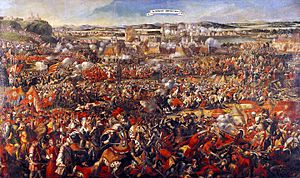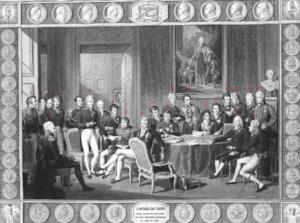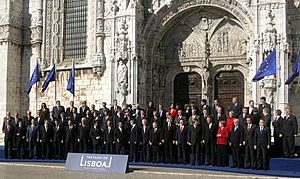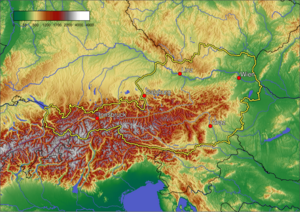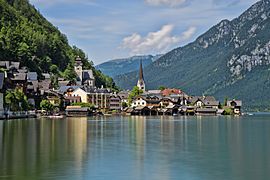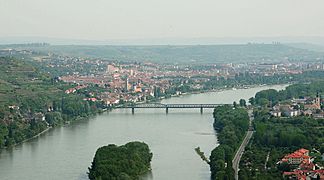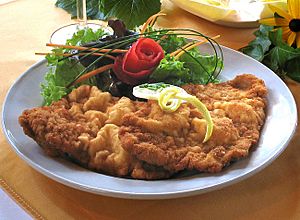Austria facts for kids
Quick facts for kids
Republic of Austria
Republik Österreich (German)
|
|
|---|---|
|
Location of Austria (dark green)
– on the European continent (green & dark grey) |
|
| Capital and largest city
|
Vienna 48°12′N 16°21′E / 48.200°N 16.350°E |
| Official languages | German |
| National language | Austrian German (Austrian) |
| Official regional languages | |
| Ethnic groups
(2023)
|
|
| Religion
(2021)
|
|
| Demonym(s) | Austrian |
| Government | Federal semi-presidential republic |
| Alexander Van der Bellen | |
| Christian Stocker | |
| Legislature | Parliament |
| Federal Council | |
| National Council | |
| Formation | |
|
• Margraviate
(oldest naming) |
c. 970 (1 November 996) |
|
• Duchy
|
17 September 1156 |
| 6 January 1453 | |
|
• Imperial circle
|
1512 |
|
• Empire
|
11 August 1804 |
| 30 March 1867 | |
| 10 September 1919 | |
|
• Federal State
|
1 May 1934 |
| 13 March 1938 | |
| 27 April 1945 | |
| 27 July 1955 | |
| Area | |
|
• Total
|
83,879 km2 (32,386 sq mi) (113th) |
|
• Water (%)
|
0.84 (2015) |
| Population | |
|
• April 2022 estimate
|
|
|
• Density
|
107.6/km2 (278.7/sq mi) (106th) |
| GDP (PPP) | 2024 estimate |
|
• Total
|
|
|
• Per capita
|
|
| GDP (nominal) | 2024 estimate |
|
• Total
|
|
|
• Per capita
|
|
| Gini (2023) | ▲ 28.1 low |
| HDI (2022) | very high · 22nd |
| Currency | Euro (€) (EUR) |
| Time zone | UTC+1 (CET) |
|
• Summer (DST)
|
UTC+2 (CEST) |
| Calling code | +43 |
| ISO 3166 code | AT |
| Internet TLD | .at |
Austria, officially called the Republic of Austria, is a country in Central Europe. It is located in the Eastern Alps. Austria is made up of nine states, and its capital, Vienna, is also the largest city.
Austria shares borders with Germany, the Czech Republic, Slovakia, Hungary, Slovenia, Italy, Switzerland, and Liechtenstein. It is a landlocked country, meaning it has no coastline. Austria covers an area of about 83,879 square kilometers (32,386 square miles) and has a population of around 9 million people.
Most people in Austria speak German. Some also speak Hungarian, Slovene, and Croatian.
Austria has a long history, going back more than a thousand years to the 9th century. The name "Ostarrichi" was first used in a document in 996. This word later became Österreich, which means "East Kingdom" in modern German.
Austria is a neutral country. This means it does not take part in wars with other countries. Austria joined the United Nations in 1955 and the European Union in 1995.
| Top - 0-9 A B C D E F G H I J K L M N O P Q R S T U V W X Y Z |
History of Austria
Ancient Times and Early Settlements
The land that is now Austria was first settled by different Celtic tribes. The city of Hallstatt has the oldest proof of Celts in Europe.
Later, the Roman Empire took over most of this area in 16 BC. It became a Roman province called Noricum until 476 AD. Other parts of Austria were in the Roman provinces of Pannonia and Raetia. An important Roman army camp, Carnuntum, was in eastern Austria. It was home to 50,000 people for almost 400 years.
Middle Ages and the Habsburgs
After the Roman Empire fell, different groups like the Germanic tribes and Slavs moved into the area. In 788, Charlemagne, the King of the Franks, conquered the land. He encouraged people to settle there and brought Christianity.
The name Ostarrîchi (Austria) was first written down in 996. In 1156, Austria became a duchy. The Habsburgs became the ruling family in 1278. They ruled Austria for a very long time, until World War I.
The Habsburgs started to gain more land in the 14th and 15th centuries. In 1438, Duke Albert V of Austria became the Holy Roman Emperor. After this, almost every emperor of the Holy Roman Empire was a Habsburg.
The Habsburgs also gained lands far away. In 1477, Maximilian married Maria of Burgundy, which added the Netherlands to their family's lands. In 1496, his son Philip the Fair married Joanna the Mad, who was the heir to Spain. This brought Spain and its lands in Italy, Africa, Asia, and the New World under Habsburg rule.
In 1526, after the Battle of Mohács, parts of Hungary and Bohemia came under Austrian rule. The Ottoman Empire tried to expand into Hungary, leading to many fights with Austria. In 1529, Suleiman the Magnificent tried to take Vienna, but he failed.
17th and 18th Centuries: Growth and Music
After Vienna was successfully defended against the Turks in 1683, Austria gained control of most of Hungary. This was made official in the Treaty of Karlowitz in 1699.
Charles VI, Holy Roman Emperor wanted his daughter, Maria Theresa, to be his heir. He made agreements with other countries to recognize her. During this time, Prussia became a strong rival to Austria. Austria also took part in dividing Poland in 1772 and 1795.
This period was also important for classical music. Many famous composers like Joseph Haydn, Wolfgang Amadeus Mozart, Ludwig van Beethoven, and Franz Schubert lived and worked in Austria.
19th Century: Wars and Changes
Austria fought against Revolutionary France and Napoleon Bonaparte. These wars were difficult for Austria, and the old Holy Roman Empire ended in 1806. In 1804, the Austrian Empire was created.
In 1814, Austria helped defeat Napoleon. At the Congress of Vienna in 1815, Austria became one of Europe's main powers. The German Confederation was formed, with Austria as its leader.
However, there were many conflicts about uniting Germany. Austria did not want to give up its German-speaking lands. In 1866, Austria fought the Austro-Prussian War against Prussia and lost. After this, Austria left the German Confederation and was no longer involved in German politics.
In 1867, the Austro-Hungarian Compromise of 1867 created Austria-Hungary. This was a dual monarchy with two parts: the Austrian Empire and the Kingdom of Hungary, both ruled by Franz Joseph I. This empire included many different groups of people, like Germans, Hungarians, Croats, Czechs, and Poles.

Ruling such a diverse empire was hard because of rising nationalist feelings. The government tried to be fair, for example, by publishing laws in eight languages and allowing schools in different languages.
Some Austrian Germans wanted Austria to join Germany. This idea was called Anschluss. They felt a strong German identity.
Early 20th Century and World War I
In 1908, Austria-Hungary took over Bosnia and Herzegovina. In 1914, Archduke Franz Ferdinand of Austria was assassinated in Sarajevo. This event led to the start of World War I. Over one million Austro-Hungarian soldiers died in the war.
After World War I, the Austro-Hungarian Empire broke apart. On October 21, 1918, German-speaking members of the parliament formed a new government in Vienna. On November 12, 1918, they declared the Republic of German-Austria. They wanted to be part of the new German republic.
However, the Treaty of Saint-Germain in 1919 stopped Austria from joining Germany. It also forced German-Austria to change its name to the "Republic of Austria," creating the First Austrian Republic. Many German-speaking Austrians found themselves living in other countries like Czechoslovakia and Yugoslavia.
Between the Wars and World War II
After World War I, Austria faced economic problems. In 1922, the League of Nations gave Austria a loan to help its economy. In 1925, the Austrian schilling currency was introduced, which was very stable.
The First Austrian Republic lasted until 1933. Then, Chancellor Engelbert Dollfuss created an autocratic government. There were clashes between political groups, leading to the Austrian Civil War in February 1934. Dollfuss was assassinated in a coup attempt by Austrian Nazis in July 1934.

His successor, Kurt Schuschnigg, wanted Austria to remain independent. He planned a vote on Austria's independence. However, on March 12, 1938, Austrian Nazis took over the government, and German troops occupied the country.
Nazi Rule in Austria
On March 13, 1938, Austria was officially joined with Nazi Germany. This event was called the Anschluss. Two days later, Adolf Hitler, who was born in Austria, announced this "reunification" in Vienna. A vote was held in April 1938, which officially confirmed the union. Most Austrians supported the Anschluss at the time, as many Germans in both Austria and Germany wanted to unite all Germans into one state.
After the Anschluss, Austria became part of the Third Reich. The Nazis immediately began taking away the wealth of Jewish Austrians. Adolf Eichmann was sent to Vienna to persecute Jews. In November 1938, Jewish people and their places of worship were attacked in many Austrian cities.
Many important Nazis were from Austria, including Adolf Hitler. About 13% of the SS members and 40% of staff at Nazi extermination camps were Austrian. In Austria, there were concentration camps like KZ-Mauthausen, where prisoners were killed and forced to work. The armaments industry grew, using forced labor to make fighter planes and tanks.
Some resistance groups tried to fight the Nazis. One important group, led by Heinrich Maier, sent information to the Allies about German armaments factories and concentration camps like Auschwitz. Their goal was to help end the war quickly and bring back an independent Austria.
Allied Occupation and Independence
Vienna fell to the Soviet forces on April 13, 1945, near the end of World War II. On April 27, 1945, Austrian leaders declared Austria's separation from the Third Reich. They formed a new temporary government in Vienna. This date is now Austria's National Day.
After World War II, Allied-occupied Austria was divided into different zones controlled by the Allied powers. Vienna was also divided, but the Austrian government was recognized by the Allies. In 1946, Austria nationalized many industries.
On May 15, 1955, after years of talks, Austria regained full independence with the Austrian State Treaty. On October 26, 1955, all foreign troops left Austria. Austria then declared its permanent neutrality, meaning it would not join military alliances.
The Second Austrian Republic's political system is based on its constitution from 1920 and 1929. Since 1945, the two main parties, the Social Democratic Party of Austria (SPÖ) and the Austrian People's Party (ÖVP), have often worked together in coalitions.
Kurt Waldheim, a former secretary-general of the United Nations, was elected President of Austria from 1986 to 1992. He had been accused of war crimes during World War II.
In 1994, Austrians voted to join the European Union. Austria became a member on January 1, 1995. While Austria remains neutral, it takes part in the EU's security policies and peacekeeping missions. Since 2011, Austria has no border controls with its neighboring countries because of the Schengen Area.
Government and Politics in Austria
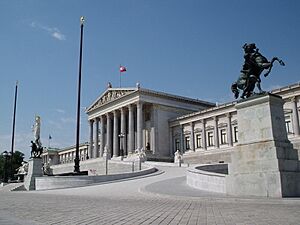
Austria is a federal republic and a representative democracy. Its government is based on the Federal Constitutional Law of 1920, which was updated in 1929 and brought back in 1945.
The president of Austria is the head of state and is chosen directly by the people. The chancellor of Austria is the head of the government. The president chooses the chancellor, who then forms a government based on the parties in parliament.
The government can be removed by the president or by a vote in the lower house of parliament, called the Nationalrat. Voting used to be required in Austria but is now optional.
Austria's parliament has two parts. The Nationalrat has 183 seats, and its members are elected every five years. Citizens aged 16 and older can vote.
The courts are the third branch of government. The Constitutional Court can cancel laws that do not follow the Constitution. Since 1995, the European Court of Justice can overrule Austrian decisions on EU laws. Austria also follows decisions from the European Court of Human Rights.
Geography of Austria
Austria is mostly a mountainous country because it is located in the Alps. The Eastern Alps make up 62% of the country's total area. Only about a quarter of Austria is low-lying land.
Austria is located between 46° and 49° North latitude and 9° and 18° East longitude.
The country can be divided into five main areas:
- The Eastern Alps: 62% of the land.
- Austrian foothills of the Alps and Carpathians: 12% of the land.
- Foothills in the east and areas around the Pannonian Plain: 12% of the land.
- Austrian granite plateau (part of the Bohemian Mass): 10% of the land.
- The Austrian part of the Vienna basin: 4% of the land.
Here are the six highest mountains in Austria:
| Name | Height | Range | |
|---|---|---|---|
| 1 | Großglockner | 3,798 m | High Tauern |
| 2 | Wildspitze | 3,772 m | Ötztal Alps |
| 3 | Kleinglockner | 3,770 m | High Tauern |
| 4 | Weißkugel | 3,739 m | Ötztal Alps |
| 5 | Pöschlturm | 3,721 m | High Tauern |
| 6 | Hörtnagelturm | 3,719 m | High Tauern |
-
View of Hallstatt
-
View of Krems at the end of Wachau valley
-
Austrian rural area of Schoppernau in summer
Climate in Austria
Most of Austria has a cool, temperate climate with humid westerly winds. Because of the Alps, the alpine climate is common in many areas. In the east, near the Pannonian Plain and the Danube valley, the climate is more continental, with less rain.
Winters in Austria are cold, with temperatures usually between -10°C and 0°C (14°F to 32°F). Summers can be quite warm, with average temperatures in the mid-20s °C (mid-70s °F). The highest temperature recorded was 40.5°C (104.9°F) in August 2013.
Administrative Divisions of Austria
Austria is a federal republic made up of nine federal states (called Bundesländer). These states are divided into districts and statutory cities. Districts are further divided into municipalities. Statutory cities act as both districts and municipalities. Vienna is special because it is both a city and a federal state.
| Federal state | Capital | Area (sq km) |
Population (1 Jan 2017) |
Density per km2 |
GDP (billion euros) (2022 Eurostat) |
GDP per capita |
|---|---|---|---|---|---|---|
| Eisenstadt | 3,965 | 291,942 | 73.6 | 10.454 | 34,900 | |
| Klagenfurt | 9,536 | 561,077 | 58.8 | 24.755 | 43,600 | |
| Sankt Pölten | 19,178 | 1,665,753 | 86.9 | 71.757 | 41,900 | |
| Salzburg | 7,154 | 549,263 | 76.8 | 33.330 | 58,900 | |
| Graz | 16,401 | 1,237,298 | 75.4 | 56.152 | 44,600 | |
| Innsbruck | 12,648 | 746,153 | 59.0 | 39.328 | 51,200 | |
| Linz | 11,982 | 1,465,045 | 122.3 | 76.780 | 50,700 | |
| 415 | 1,867,582 | 4,500 | 110.992 | 56,600 | ||
| Bregenz | 2,601 | 388,752 | 149.5 | 23.588 | 58,300 | |
Economy in Austria
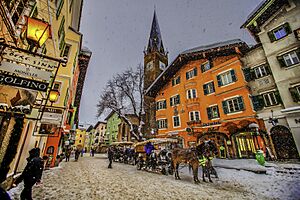
Austria has a very developed economy. Besides its strong industry, international tourism is a very important part of Austria's economy.
Historically, Germany has been Austria's main trading partner.

Austria gets more than half of its electricity from hydropower (power from water). When you add other renewable energy sources like wind power, solar power, and biomass, over 60% of Austria's electricity comes from renewable energy.
Rail transport in Austria is mainly provided by the national railway company, Austrian Federal Railways (ÖBB). They operate most local and long-distance trains.
People and Culture of Austria
Population and Cities

In April 2016, Austria's population was about 8.72 million. The capital city, Vienna, has over 1.8 million people (or 2.6 million if you include the suburbs). This means about a quarter of the country's population lives in Vienna. Vienna is known for its culture and high quality of life.
After Vienna, the largest cities are:
Other cities in Austria have fewer than 100,000 people.
In 2010, about 1.27 million people living in Austria were born in another country. Many of these people came from other EU countries or from outside the EU. Some of the largest minority groups include people from Turkey, Serbia, Croatia, Bosnia, and Slovenia.
Music and Arts
Many famous composers were from Austria or lived there. These include:
- Wolfgang Amadeus Mozart
- Joseph Haydn
- Franz Schubert
- Anton Bruckner
- Johann Strauss, Sr.
- Johann Strauss, Jr.
- Gustav Mahler
In more modern times, composers like Arnold Schoenberg, Anton Webern, and Alban Berg were part of the "Second Viennese School" of music.
Austria also has many famous artists, such as:
Austrian Food
Austrian food comes from the traditions of the Austro-Hungarian Empire. It is known for its balanced dishes with beef and pork, and many kinds of vegetables.
Austrian bakeries are famous for "Mehlspeisen" (flour dishes). Some popular treats include:
- Sachertorte (a chocolate cake)
- "Krapfen" (doughnuts, often filled with apricot jam)
- "Strudel" (pastries with fillings like apple or cheese curd)
Austrian cuisine has also been influenced by Hungarian, Czech, Italian, Balkan, and French cooking. This makes it one of the most multicultural food traditions in Europe.
Some typical Austrian dishes are:
- Wiener Schnitzel (a thin, breaded, pan-fried cutlet)
- Schweinsbraten (roast pork)
- Kaiserschmarrn (shredded pancake)
- Knödel (dumplings)
- Tafelspitz (boiled beef)
- Kärntner Kasnudeln (dough pockets filled with cheese, potatoes, and herbs)
The candy dispenser Pez and the wafer cookies Mannerschnitten were invented in Austria. Austria is also known for its Mozartkugeln chocolates and its coffee culture.
Drinks in Austria
Beer is very popular in Austria. It is sold in different sizes, like 0.2, 0.3, and 0.5 liters. At festivals, you can find one-liter and two-liter mugs. The most popular types of beer are lager and wheat beer.
The most important wine-making areas are in Lower Austria, Burgenland, Styria, and Vienna. The Grüner Veltliner grape makes some of Austria's best white wines. Zweigelt is the most common red wine grape.
In some parts of Austria, Most is made. This is a type of cider or perry (from pears).
Schnapps is a strong fruit brandy, often with up to 60% alcohol. It is made from fruits like apricots and rowanberries. Small private distilleries make their own schnapps, called Selbstgebrannter.
Popular non-alcoholic drinks include Almdudler and "Spetzi" (a mix of Coca-Cola and orange soda). Red Bull, the world's best-selling energy drink, was also invented in Austria.
UNESCO World Heritage Sites in Austria
Austria has many places recognized by UNESCO for their special cultural or natural importance:
- Historic Centre of Salzburg (1996)
- Schönbrunn Palace (1996)
- Hallstatt–Dachstein Salzkammergut Cultural Landscape (1997)
- Semmering Railway (1998)
- Historic Centre of Graz and Schloss Eggenberg (1999, extended 2010)
- Wachau Cultural Landscape (2000)
- Historic Centre of Vienna (2001)
- Lake Neusiedl (2001)
Gallery of World Heritage Sites
See Also
 In Spanish: Austria para niños
In Spanish: Austria para niños
Images for kids
-
Bilingual sign of Oberwart (in Hungarian Felsőőr) in Burgenland
-
The campus of JKU University of Linz
-
Wolfgang Amadeus Mozart (1756–1791)
-
Arnold Schwarzenegger is a well-known Austrian and American actor.
-
Innsbruck hosted the 1964 and 1976 Winter Olympics, as well as the 2012 Winter Youth Olympics, the first in history.
-
Ski racer Franz Klammer won a gold medal at the 1976 Winter Olympics in Innsbruck.






